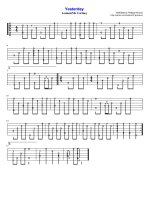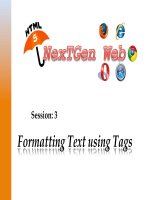Session 09 XP tủ tài liệu bách khoa
Bạn đang xem bản rút gọn của tài liệu. Xem và tải ngay bản đầy đủ của tài liệu tại đây (2.5 MB, 56 trang )
Fundamentals of Java
Describe field and method modifiers
Explain the different types of modifiers
Explain the rules and best practices for using field modifiers
Describe class variables
Explain the creation of static variables and methods
Describe package and its advantages
Explain the creation of user-defined package
Explain the creation of .jar files for deployment
© Aptech Ltd.
Modifiers and Packages/Session 9
2
Java is a tightly encapsulated language.
Java provides a set of access specifiers such as public, private,
protected, and default that help to restrict access to class and class
members.
Java provides additional field and method modifiers to further restrict access
to the members of a class to prevent modification by unauthorized code.
Java provides the concept of class variables and methods to create a common
data member that can be shared by all objects of a class as well as other
classes.
Java provides packages that can be used to group related classes that share
common attributes and behavior.
The entire set of packages can be combined into a single file called the .jar
file for deployment on the target system.
© Aptech Ltd.
Modifiers and Packages/Session 9
3
Field and method modifiers are keywords used to identify fields and methods that
provide controlled access to users.
Some of these can be used in conjunction with access specifiers such as public
and protected.
The different field modifiers that can be used are as follows:
volatile
native
transient
final
© Aptech Ltd.
Modifiers and Packages/Session 9
4
The volatile modifier allows the content of a variable to be synchronized across
all running threads.
A thread is an independent path of execution of code within a program. Many threads can
run concurrently within a program.
The volatile modifier is applied only to fields.
Constructors, methods, classes, and interfaces cannot use this modifier.
The volatile modifier is not frequently used.
While working with a multithreaded program, the volatile keyword is used.
© Aptech Ltd.
Modifiers and Packages/Session 9
5
When multiple threads of a program are using the same variable, in general, each
thread has its own copy of that variable in the local cache.
In such a case, if the value of the variable is updated, it updates the copy in the
local cache and not the main variable present in the memory.
The other thread using the same variable does not get the updated value.
To avoid this problem, a variable is declared as volatile to indicate that it will not
be stored in the local cache.
Whenever a thread updates the values of the variable, it updates the variable present
in the main memory.
This helps other threads to access the updated value.
For example,
private volatile int testValue; // volatile variable
© Aptech Ltd.
Modifiers and Packages/Session 9
6
The native modifier is used only with methods.
It indicates that the implementation of the method is in a language other than Java
such as C or C++.
Constructors, fields, classes, and interfaces cannot use this modifier.
The methods declared using the native modifier are called native methods.
The Java source file typically contains only the declaration of the native method and
not its implementation.
The implementation of the method exists in a library outside the JVM.
Before invoking a native method, the library that contains the method implementation
must be loaded by making the following system call:
System.loadLibrary(“libraryName”);
To declare a native method, the method is preceded with the native modifier.
The implementation is not provided for the method. For example,
public native void nativeMethod();
© Aptech Ltd.
Modifiers and Packages/Session 9
7
After declaring a native method, a complex series of steps are used to link it with the
Java code.
Following code snippet demonstrates an example of loading a library named
NativeMethodDefinition containing a native method named
nativeMethod():
class NativeModifier {
native void nativeMethod(); // declaration of a native method
/**
* static code block to load the library
*/
static {
System.loadLibrary(“NativeMethodDefinition”);
}
/**
* @param args the command line arguments
*/
public static void main(String[] args) {
NativeModifier objNative = new NativeModifier(); // line1
objNative.nativeMethod(); // line2
}
}
© Aptech Ltd.
Modifiers and Packages/Session 9
8
Notice that a static code block is used to load the library.
The static keyword indicates that the library is loaded as soon as the class is loaded.
This ensures that the library is available when the call to the native method is made.
The native method can be used in the same way as a non-native method.
Native methods allow access to existing library routines created outside the JVM.
However, the use of native methods introduces two major problems.
Impending security risk
• The native method executes actual machine code, and therefore, it can gain
access to any part of the host system.
• That is, the native code is not restricted to the JVM execution environment.
• This may lead to a virus infection on the target system.
Loss of portability
• The native code is bundled in a DLL, so that it can be loaded on the machine on
which the Java program is executing.
• Each native method is dependent on the CPU and the OS.
• This makes the DLL inherently non-portable.
• This means, that a Java application using native methods will run only on a
machine in which a compatible DLL has been installed.
© Aptech Ltd.
Modifiers and Packages/Session 9
9
When a Java application is executed, the objects are loaded in the Random Access
Memory (RAM).
Objects can also be stored in a persistent storage outside the JVM so that it can be
used later.
This determines the scope and life span of an object.
The process of storing an object in a persistent storage is called serialization.
For any object to be serialized, the class must implement the Serializable
interface.
If transient modifier is used with a variable, it will not be stored and will not
become part of the object’s persistent state.
The transient modifier is useful to prevent security sensitive data from being
copied to a source in which no security mechanism has been implemented.
The transient modifier reduces the amount of data being serialized, improves
performance, and reduces costs.
© Aptech Ltd.
Modifiers and Packages/Session 9
10
The transient modifier can only be used with instance variables.
It informs the JVM not to store the variable when the object, in which it is declared, is
serialized.
Thus, when the object is stored in persistent storage, the instance variable declared as
transient is not persisted.
Following code snippet depicts the creation of a transient variable:
class Circle {
transient float PI; // transient variable that will not persist
float area; // instance variable that will persist
}
© Aptech Ltd.
Modifiers and Packages/Session 9
11
The final modifier is used when modification of a class or data member is to be
restricted.
The final modifier can be used with a variable, method, and class.
Final Variable
A variable declared as final is a constant whose value cannot be modified.
A final variable is assigned a value at the time of declaration.
A compile time error is raised if a final variable is reassigned a value in a program
after its declaration.
Following code snippet shows the creation of a final variable:
final float PI = 3.14;
The variable PI is declared final so that its value cannot be changed later.
© Aptech Ltd.
Modifiers and Packages/Session 9
12
Final Method
A method declared final cannot be overridden or hidden in a Java subclass.
The reason for using a final method is to prevent subclasses from changing the
meaning of the method.
A final method is commonly used to generate a random constant in a
mathematical application.
Following code snippet depicts the creation of a final method:
final float getCommission(float sales){
System.out.println(“A final method. . .”);
}
The method getCommission() can be used to calculate commission based on
monthly sales.
The implementation of the method cannot be modified by other classes as it is
declared as final.
A final method cannot be declared abstract as it cannot be overridden.
© Aptech Ltd.
Modifiers and Packages/Session 9
13
Final Class
A class declared final cannot be inherited or subclassed.
Such a class becomes a standard and must be used as it is.
The variables and methods of a class declared final are also implicitly final.
The reason for declaring a class as final is to limit extensibility and to prevent the
modification of the class definition.
Following code snippet shows the creation of a final class:
public final class Stock {
...
}
The class Stock is declared final.
All data members within this class are implicitly final and cannot be modified by
other classes.
© Aptech Ltd.
Modifiers and Packages/Session 9
14
Following code snippet demonstrates an example of creation of a final class:
package session9;
public class Final {
// Declare and initialize a final variable
final float PI = 3.14F; // variable to store value of PI
/**
* Displays the value of PI
*
* @param pi a float variable storing the value of PI
* @return void
*/
public void display(float pi) {
PI = pi; // generates compilation error
System.out.println(“The value of PI is:”+PI);
}
/**
* @param args the command line arguments
*/
public static void main(String[] args) {
© Aptech Ltd.
Modifiers and Packages/Session 9
15
// Instantiate the Final class
final Final objFinal = new Final();
// Invoke the display() method
objFinal.display(22.7F);
}
}
The class Final consists of a final float variable PI set to 3.14.
The method display() is used to set a new value passed by the user to PI .
This leads to compilation error ‘cannot assign a value to final
variable PI’.
If the user chooses to run the program anyway, the following runtime error is issued as
shown in the following figure:
To remove the error, the method signature should be changed and the statement,
PI = pi; should be removed.
© Aptech Ltd.
Modifiers and Packages/Session 9
16
Some of the rules for using field modifiers are as follows:
Final fields cannot be volatile.
Native methods in Java cannot have a body.
Declaring a transient field as static or final should be avoided as far as
possible.
Native methods violate Java’s platform independence characteristic. Therefore,
they should not be used frequently.
A transient variable may not be declared as final or static.
© Aptech Ltd.
Modifiers and Packages/Session 9
17
Consider a situation, where in a user wants to create a counter that keeps track
of the number of objects accessing a particular method.
In such a scenario, a variable is required that can be shared among all the
objects of a class and any changes made to the variable are updated only in one
common copy.
Java provides the implementation of such a concept of class variables by using
the static keyword.
© Aptech Ltd.
Modifiers and Packages/Session 9
18
Class variables are also known as static variables.
Note that the static variables are not constants.
Such variables are associated with the class rather than with any object.
All instances of the class share the same value of the class variable.
The value of a static variable can be modified using class methods or instance methods.
Unlike instance variable, there exists only one copy of a class variable for all objects in one
fixed location in memory.
A static variable declared as final becomes a constant whose value cannot be modified.
For example,
static int PI=3.14; // static variable-can be modified
static final int PI=3.14; // static constant-cannot be
modified
© Aptech Ltd.
Modifiers and Packages/Session 9
19
One can also create static methods and static initializer blocks along with
static variables.
Static variables and methods can be manipulated without creating an instance
of the class.
This is because there is only one copy of a static data member that is shared by
all objects.
A static method can only access static variables and not instance variables.
Methods declared as static have the following restrictions:
Can invoke only
static methods
Can access only
static data
© Aptech Ltd.
Cannot use this or
super keywords
Modifiers and Packages/Session 9
20
Generally, a constructor is used to initialize variables.
However, a static block can also be used to initialize static variables because
static block is executed even before the main() method is executed.
It is used when a block of code needs to be executed during loading of the class by
JVM.
Execution of Java code starts from static blocks and not from main() method.
It is enclosed within {} braces.
There can be more than one static block in a program. They can be placed
anywhere in the class.
A static initialization block can reference only those class variables that have
been declared before it.
© Aptech Ltd.
Modifiers and Packages/Session 9
21
Following code snippet demonstrates an example of static variables, static
method, and static block:
package session9;
public class StaticMembers {
// Declare and initialize static variable
public static int staticCounter = 0;
// Declare and initialize instance variable
int instanceCounter = 0;
/**
* static block
*
*/
static{
System.out.println(“I am a static block”);
}
/**
* Static method
*
* @return void
© Aptech Ltd.
Modifiers and Packages/Session 9
22
*/
public static void staticMethod(){
System.out.println(“I am a static method”);
}
/**
* Displays the value of static and instance counters
*
* @return void
*/
public void displayCount(){
//Increment the static and instance variable
staticCounter++;
instanceCounter++;
// Print the value of static and instance variable
System.out.println(“Static counter is:”+ staticCounter);
System.out.println(“Instance counter is:”+ instanceCounter);
}
© Aptech Ltd.
Modifiers and Packages/Session 9
23
/**
* @param args the command line arguments
*/
public static void main(String[] args) {
System.out.println(“I am the main method”);
// Invoke the static method using the class name
StaticMembers.staticMethod();
// Create first instance of the class
StaticMembers objStatic1 = new StaticMembers();
objStatic1.displayCount();
// Create second instance of the class
StaticMembers objStatic2 = new StaticMembers();
objStatic2.displayCount();
// Create third instance of the class
StaticMembers objStatic3 = new StaticMembers();
objStatic3.displayCount();
}
}
© Aptech Ltd.
Modifiers and Packages/Session 9
24
Following figure shows the output of the program:
From the figure it is clear that the static block is executed even before the main()
method.
Also, the value of static counter is incremented to 1, 2, 3, …, and so on whereas the
value of instance counter remains 1 for all the objects.
This is because a separate copy of the instance counter exists for each object.
However, for the static variable, only one copy exists per class.
Every object increments the same copy of the variable, staticCounter.
Thus, by using a static counter, a user can keep track of the number of instances of
a class.
© Aptech Ltd.
Modifiers and Packages/Session 9
25









